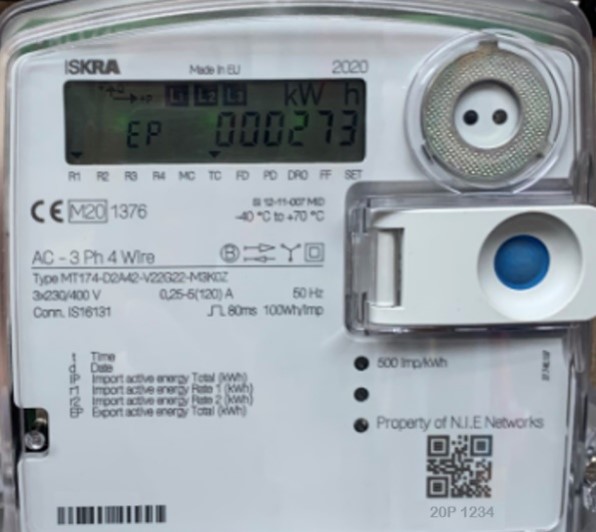Have you ever glanced at your electricity meter and wondered what those numbers really mean? Understanding how to read your import/export electricity meter can be a game-changer.
Not only does it help you monitor your energy consumption, but it also empowers you to make smarter decisions about your energy usage. If you’re curious about how much energy your solar panels are sending back to the grid or simply want to keep a closer eye on your electricity bills, you’re in the right place.
In this guide, you’ll discover simple, step-by-step instructions that will demystify your electricity meter. Get ready to take control of your energy habits and potentially save money along the way. Don’t let those numbers remain a mystery—unlock the secrets of your electricity meter now!

Credit: powerni.co.uk
Understanding Electricity Meters
Electricity meters measure the power used in homes and buildings. There are two main types: analog and digital meters. Analog meters have spinning dials. The more the dials spin, the more power used. Digital meters show numbers on a screen. They are easy to read. Both types help track electricity usage. This helps you manage energy bills.
Meters have different parts. The display shows the power used. The sensor measures electricity flow. The input terminal connects to the power line. Each part has a job. Together, they help measure electricity. Knowing these parts helps understand how meters work.

Credit: powerni.co.uk
Reading Import/export Meters
Electricity meters show how much power you use. They also show how much you send back. Import readings are for power you use. Export readings are for power you send back. Many meters have labels. Look for “IMP” for import and “EXP” for export. It helps in understanding your bill. Always write down the numbers carefully. This keeps your records correct.
Digital meters are easy to read. They have a clear screen. Numbers show directly. Analog meters have dials. Dials can be hard to read. Each dial turns in a different way. You must read from left to right. Write down each number as you read it. This helps avoid mistakes.
Tools And Equipment Needed
To read an electricity meter, you need some basic tools. A flashlight helps you see in dark corners. A notebook is useful for jotting down numbers. A pen or pencil is essential to write clearly. A calculator makes it easy to add numbers. A smartphone can capture photos of the meter readings. These tools make the job simple and quick.
Safety is very important when reading meters. Wear gloves to protect your hands from dirt. Safety goggles keep your eyes safe from dust. Sturdy shoes help prevent slips or falls. A helmet can protect your head in tight spaces. Use these items to stay safe while working.
Step-by-step Reading Process
Ensure safety first. Wear gloves if necessary. Check your meter box. Make sure it is clean. Ensure the area is well-lit. Grab a pen and paper. Note down any numbers you see. Look for the display screen. It shows important data.
Digital meters have screens. Look at the numbers. Focus on total usage. The screen may change. Wait for the numbers to settle. Write down these numbers. They show how much electricity you use. Note each important detail. Double-check to ensure accuracy.
Analog meters have dials. Observe the needle. It points to numbers. Read from left to right. Each dial shows different digits. Write these numbers in order. Check if the needle is between numbers. Use lower number if unsure. Record carefully for correct results.
Common Errors And Troubleshooting
Many people read electricity meters wrong. They miss some digits or numbers. This leads to wrong readings. These mistakes can cause high bills. Some confuse the import and export readings. It’s important to know which is which. Check if the meter display works fine. Sometimes, it shows errors. A blinking display means trouble. Check connections and ensure wires are tight. This helps get the right reading.
Fixing meter issues is easy. First, check the manual for help. Manuals have important details. If the display blinks, it needs attention. Reset the meter if possible. Some meters have reset buttons. Another fix is to restart the system. Turn off the power and turn it on again. This often solves display errors. If problems continue, ask an expert. Experts can fix technical issues quickly.

Credit: www.youtube.com
Best Practices For Accuracy
Regular monitoring of electricity meters ensures accurate readings. Check the meter weekly or monthly. This helps spot any unusual changes. Record the readings in a log book. This creates a useful history. Use a flashlight to see the numbers clearly. Clean the meter glass if it’s dirty.
Verification techniques are key for precise readings. Compare your records with the utility bill. This confirms the meter’s accuracy. Use a calculator to add up daily readings. Check if they match the monthly bill. Contact the electricity company if you spot errors. They can inspect the meter for issues.
Legal And Regulatory Considerations
Compliance requirements are rules that must be followed. These rules ensure that electricity meters are read correctly. Meters must be installed by qualified professionals. This helps avoid errors. Checking the meter regularly is important. This ensures accurate readings. Follow the rules for safety.
Reporting standards are guidelines for sharing information. They help keep records clear. Reports must be easy to understand. Use simple language in reports. Share data in a structured format. This helps others read it easily. Follow reporting rules to avoid mistakes.
Future Of Electricity Meters
Electricity meters are getting smarter. They can now talk to us. These smart meters send data to phones and computers. No need to read numbers manually. They help save time and effort. People can see how much electricity they use each day. This helps in saving energy and money. These meters help in tracking usage easily.
Smart meters make it easy to use less electricity. They show which appliance uses the most power. This helps families save money on bills. Power companies also benefit. They can manage electricity better. This reduces blackouts and power cuts. Smart meters help in making electricity usage clear. This is good for both people and the environment.
Frequently Asked Questions
How Do I Read An Import/export Meter?
To read an import/export meter, locate the display panel. It typically cycles through readings for energy imported and exported. Note the numbers displayed under “Import” for energy used and “Export” for energy sent back to the grid. Each section might have a specific unit, like kilowatt-hours (kWh).
What Do Import/export Readings Mean?
Import/export readings indicate your energy consumption and production. “Import” shows the electricity you’ve used from the grid. “Export” represents the energy your system has generated and returned to the grid. Understanding these readings helps manage your energy usage and optimize savings.
Why Is My Export Reading Important?
Your export reading is crucial if you have solar panels. It shows how much energy you send back to the grid. This can affect your energy bills and potential credits received. Monitoring this helps you assess the efficiency of your solar system and maximize financial benefits.
Can I Check My Meter Readings Online?
Many modern electricity meters allow online monitoring. Check with your utility provider for access. This feature helps track energy usage and generation remotely. It provides insights into consumption patterns, which can lead to better energy management and cost savings.
Conclusion
Reading an import/export electricity meter is simple with practice. Knowing how to read it helps manage energy use. It also aids in understanding your electricity bill better. This skill can lead to smarter energy choices. Start by identifying the meter type.
Then, follow the steps we discussed. With time, it will become second nature. Remember to note readings regularly. This way, you can track changes easily. Stay informed and make energy decisions wisely. Keep this guide handy for future reference.
